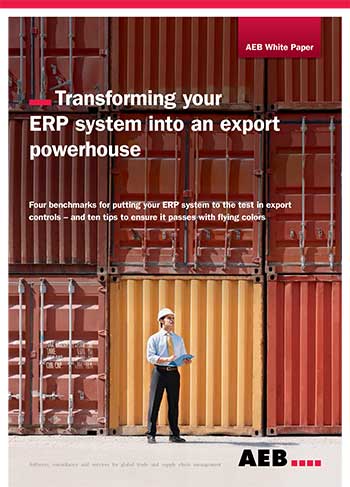Building A Future In Changing Port Landscapes: Best Practices For Implementing A Rugged Mobile Computing Solution In A Port Warehouse Environment


The World Trade Organisation expects world trade to grow 5.3% in 2015. This anticipated growth in world trade is reflected in the demand for port side warehousing, which is also growing at a rapid rate. In its financial statement in October 2014, DP World, owner of the container terminal London Gateway (UK), reported an 8% increase in gross container volumes globally with forecasted growth of 5%. Reports suggest that demand in Europe could reach 215-323 million sq feet by 2030, representing a 40-60% increase on today’s existing warehouse space.
To cope with the increase in demand and growth, port facilities are evolving into state-of-the-art complexes that offer a single solution for all businesses involved in the movement of goods and freight. Flexible “on demand” and scalable warehousing is critical to allow for expansion at peak times, enable efficient use of storage space and provide effective asset management.
This article covers:
- Planning and designing a scalable, rugged mobile computing solution
- The external forces that will influence the way the solution is structured and managed
- Consideration for a future-proofed mobile computing solution
Port facilities must be able to implement, support and deliver the latest technologies to support growth and expansion while dealing with the day-to-day movement of a vast quantity and range of goods. The port warehouse of the future must be prepared for growth and able to integrate the most effective technologies to offer competitive advantage. At the heart of it all should be communication.
The predicted demands on port warehousing means that any port centric facility must not only attain the efficiency and accuracy gains that mobile computing solutions offer from day one, but also provide a scalable and flexible solution to meet future demands in a seamless way. Incorporating a service and support package in the design and implementation is a proven way to build in agility and can be more cost effective in the long-run.
Of course, it’s important to start with the correct rugged mobile computing solution, which requires careful planning and preparation.
This whitepaper draws together over thirty years’ experience of helping the warehouse industry excel in the design and deployment of rugged mobile solutions, and will detail the component parts for success, from understanding if you are ready for growth, through to identifying the technology gaps that need to be plugged.
Planning for port growth and expansion
A sophisticated warehouse management system (WMS) integrated with the right IT systems can deliver up to the minute information to management and customers. This valuable insight is what sets businesses apart from their competition. The ability to predict capacity, peak flow of containers, and be in a position to manage unexpected busy times are all features that a logistics manager should expect to be inherent in the selected solution. Ports with advanced logistics are better positioned to win new business, and working with a logistics expert can help to build a strong case. The key is to ensure that you partner with a logistics expert who understands your business challenges and can help refine and establish your operational and strategic objectives.
The best solutions will offer real-time system functionality combined with versatile mobile devices, ensuring that increased volumes of cargo handled by a port are managed effectively and accurately. Enabling increased productivity, greater accuracy and increasing efficiency throughout the operation, will ensure that SLAs are met, or even exceeded. Knowing exactly what is going on in a single moment of time is utopia and can be a powerful tool for operators to wield.
So how do you achieve it?
Our experience has led us to devise a five-point plan that includes the major considerations for success. It’s a tried and tested approach that reflects the years of involvement in major transformational projects.
1. Be clear about what you want. Start with your business plan. Where’s the opportunity for you in three, five and ten year’s time? Are there contracts you could win if you diversified using technology to either make you more efficient, or give you the ability to handle different types of cargo? For example, perishable commodities such as fruit, vegetables and fruit juices can be severely compromised and result in the loss of an entire shipment if time is wasted searching for containers that have not been placed where they should have been. Customers and contracts can be lost as a result. Working with a supply chain expert can help you identify the best technologies to help fulfil these and identify other opportunities. In which direction do you think your competitors will go and how can you differentiate?
2. Next it’s important to work out the gaps in your capability that would inhibit your ambition. What technology do you have now and what do you think you need to bridge the commercial gap you’ve identified? What are the limitations and how can they be overcome?
It’s an absolute certainty that you will need a warehouse management system and a fleet of mobile devices, including scanners through to printers that will ensure all goods in and out are tracked and traceable at a moment’s notice. Advanced logistics capabilities can also save time, costs and reduce the possibility of human error that can occur in a fast-moving port environment.
With so much choice available it is also important to consider the right mobile and data capture technology devices that will suit the different requirements you’ll need to serve as your strategy evolves. The harsh port environment will pre-determine some of the specifications such as ruggedness and a device’s robustness if dropped, through to secure cases that prevent water damage, but it’s important to draw up a check-list of factors that are important to that may include:
- Form factor: should they be gun-style, handheld, tablet or vehicle mounted?
- Ergonomics and Data Entry – Does it need to be lightweight, is there a lot of data entry involved? Data capture: Are they required to capture barcodes, images or signatures?
- Output: Does the solution need to include a rugged mobile printer solution?
It’s also really important to ask what you will do with the man hours the implementation will save – will it give you the option to do more with the resources you have in the space you operate, broadening your offering?
As part of this review, make sure you don’t overlook the capability of the communication network. Your investment would be worthless if you can’t seamlessly move from warehouse to harbour-side. This could include checking the networks you will use are secure, through to ensuring it will reach through containers when the port is at its busiest. One of the key considerations will be to decide between wireless local-area networks (WLAN) and wireless wide-area networks (WWAN). While WLAN networks will provide ample coverage within a small geographic space – typically up to 300 feet – WWAN can provide network access to a much larger area.
3. The next important question to ask is whether technology is all you have to worry about. Make sure you consider how you need to change your footprint and your physical assets such as loading bays for roll on-roll off stock and actual warehouse square footage. If you want to expand but have to use the space you have, will technology help you overcome some of the perceived restrictions? If you can speed up the time it takes to unload, will you be able to service more shipments?
It is also worth considering what infrastructure is provided by the port terminal operator. The changing face of port warehousing can be seen in the rising popularly of Common User Facilities (CUF) at ports. These facilities are run by third parties and allow occupiers to share equipment.
CUF will be highly attractive to SMEs that do not require large standalone dedicated distribution centres of their own. However, CUF and ‘port centric’ distribution will also appeal to larger businesses that need supplementary capacity. In either case, flexibility will be key and devices will need to be able to cope with a number of job functions.
In this situation, it is imperative that operators partner with a supplier that can tailor solutions and provide seamless operation, visibility and additional services, but is equally flexible enough to be switched off without cost.
4. A venture that will transform your business needs experience. Identify the partner with the right technology mix who will help you design the network and identify the devices it supports, understand the integration roadmap, oversee the roll out, and will support you on the less tangible but crucial items such as training. It’s about striking the right balance. Deploying a new solution does not mean that current operations have to grind to a halt. As we’ve already mentioned, taking the time to find a supplier who can provide the right support, understand your business, integrate the hardware and software and provide a future-proof solution will be the foundation for success.
With so much choice on the market for WMS and Automatic Identification and Data Capture (AIDC) solutions, it’s important to do your homework. Many solutions are designed to be rapidly deployed and cause minimal downtime and reduction in unnecessary costs.
However, make sure deployments are not so rapid that the fundamentals are not bedded in properly. It’s true the choice of operating system, an easy to use WMS, combined with thorough and engaging training will help to realise the benefits quickly, but a considered phased approach, that incorporates all the considerations of the five step plan above, needs to underpin it or you’ll solicit trouble.
5. Finally, your people can be your secret weapon in a roll out such as this. Include them as you identify the processes that need to be stopped, improved or introduced. Extend their involvement to the trials. They will act as ambassadors and ensure you get buy-in quickly so you reach your efficiency goals quickly.
Shipping Forecast – Implementing a solution that is right for today and the future
An effective rugged mobile computing solution is one that deploys the right technologies in the right areas. There is no ‘one size fits all’ solution, and with future- proofing it is important to work with a provider who can offer a range of rugged devices within a fully integrated warehouse management solution.
The AIDC market is evolving, so it is vital you are not blinded by market innovations only to realise that the solution is no longer effective 12 months down the line. Selecting a partner with the experience to bring their knowledge of how the market will evolve will allow you to design a solution that will stand the test of time, with the flexibility to shift direction as new technological developments become available, or your strategy takes a departure.
Want more like this?
Want more like this?
Insight delivered to your inbox
Keep up to date with our free email. Hand picked whitepapers and posts from our blog, as well as exclusive videos and webinar invitations keep our Users one step ahead.
By clicking 'SIGN UP', you agree to our Terms of Use and Privacy Policy


By clicking 'SIGN UP', you agree to our Terms of Use and Privacy Policy
Other content you may be interested in
Categories

Want more like this?


Want more like this?
Insight delivered to your inbox
Keep up to date with our free email. Hand picked whitepapers and posts from our blog, as well as exclusive videos and webinar invitations keep our Users one step ahead.
By clicking 'SIGN UP', you agree to our Terms of Use and Privacy Policy









